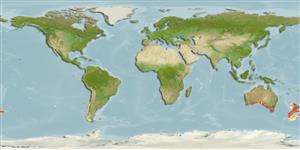Preferred temperature (Ref.
115969): 9.7 - 15.4, mean 13 (based on 84 cells).
Phylogenetic diversity index (Ref.
82804): PD
50 = 0.5156 [Uniqueness, from 0.5 = low to 2.0 = high].
Bayesian length-weight: a=0.00955 (0.00485 - 0.01879), b=3.13 (2.95 - 3.31), in cm Total Length, based on LWR estimates for this species & (Sub)family-body (Ref.
93245).
營養階層 (Ref.
69278): 3.5 ±0.41 se; based on food items.
回復力 (Ref.
120179): 中等的, 族群倍增時間最少 1.4 - 4.4年 (K=0.36; tm=3-4; tmax=15).
Prior r = 0.70, 95% CL = 0.46 - 1.05, Based on 2 stock assessments.
Fishing Vulnerability (Ref.
59153): Low to moderate vulnerability (33 of 100).
Climate Vulnerability (Ref.
125649): High to very high vulnerability (74 of 100).
